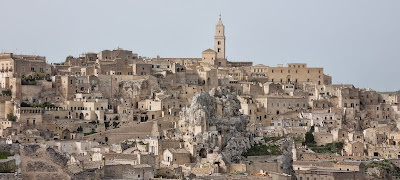30 March 2024 – Matera
Miles
driven today = 51
Total Miles
to date = 3,111
Today’s
drive was entirely without incident and, with great roads to whisk us on our
way, it took only a little over an hour to complete. We continued along the E90 to Metaponto,
where we had originally planned to spend last night, before heading inland on
the SP3. The hazy conditions had
returned so we saw very little of the hills until we were among them, climbing
to 400 metres above Sea level by the time we reached Matera.
Our home
for tonight, and probably tomorrow night too, is on a sosta at an old Go-Kart
track a couple of miles out of town. At
€25 a night without electric, it’s not cheap, but we quickly found out why this
place has rave reviews. Our host,
Gianfranco, is a fabulous chap. He took
time to provide us with a map of the town and gave us lots of recommendations
on places to see. He also provides a
free shuttle service into town so armed with his pearls of wisdom we set out to
see what this place has to offer.
Firstly we made our way to the Piazza Vittorio Veneto from where we could take in our first view across the town while being serenaded by local folk musicians. The old part of Matera is divided into two parts The Sasso Barisano, which we can see here overlooked by the town’s Cathedral, and the Sasso Caveoso. Jointly they are simply called the Sassi.
In the Piazza we found one of a number of sculptures which are scattered around the town, created by Andrea Roggi.
Before exploring further we noticed a number of market stalls up a side street selling all manner of local traditional fair so we had a good look but resisted any purchases.
We found our way up to the Duomo. It appeared to be shut for lunch but on this occasion we were a lot more interested in seeing one of the more than 150 “rock churches” which are hewn into the sandstone.
This was the view looking back across Sasso Barisano from the Duomo. In Materan society the rich would live in stone-built Palazza on the higher ground whereas the less well off would live in cave houses further down the hill. Naturally waste and detritus would flow downhill and so the Sassi became malaria-ridden slums. The last 20,000 people to live in these houses were forcibly evicted in the 1950s and made to move to new homes built nearby. EU and private investment has subsequently seen the areas repopulated and rejuvenated.
The Church to the left is San Pietro Caveoso with its Piazza to the front. At the top centre of the shot, built into the rocky outcrop, are the joint Churches of Santa Maria de Idris and San Giovanni in Monterrone.
We climbed the steps up to the rock churches and paid €4 each to go inside.
No photography is allowed, although I did sneakily take this poorly aligned shot of the alter in the 14th Century Church of Santa Maria. To the bottom left you can just see the top of a doorway which Lisa is about to walk through leading to the Church of San Giovanni. This was entirely hewn out of solid rock and is believed to date back to the 11th Century. A lot of the ancient frescos are still clearly visible although sadly some of them appear to have been vandalized at some point.
These are very typical Sassi dwellings.
A number of cave houses have been renovated and made to represent how they would have looked before they were abandoned in the 1950s. We took a look around one which Gianfranco recommended to be the most interesting.
Inhabitants would even keep their animals in the houses with them. I can’t imagine they would have smelt particularly great.
This was a Neviera, which the information boards translated as a “snow cistern” but we would know as an Icehouse. Inhabitants would collect snow and ice in the Winter and store it here to keep things cool in the warmer months.
Another rock church. There is documentary evidence that this one was already in existence in 1233, although some are thought to date back as far as the 8th Century.
The view looking the other way up the gorge with a footbridge at the bottom of the track which zig-zags up to the viewpoint on the other side.
Another view of the cave houses in Sasso Caveoso.
Time for a well earned cup of coffee and a slab of traditional local Easter Cake.
Looking back towards the Duomo from the other side of Sasso Caveoso.
This impressive 17th Century Palazzo houses one of the town’s museums nowadays.
The Church of Sant Agostino with another of Andrea Roggi’s creations.
One final look at Sasso Barisano from a slightly different and lower angle.




























Comments
Post a Comment